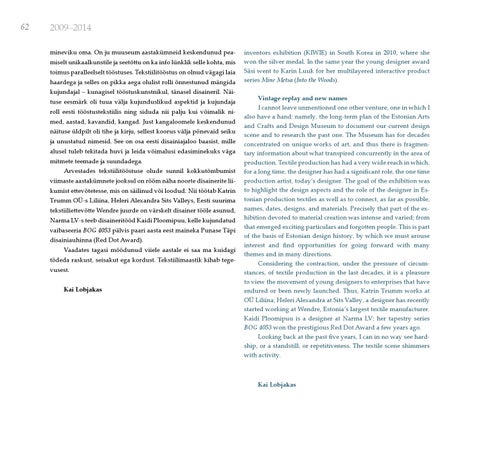62
2009–2014 mineviku oma. On ju muuseum aastakümneid keskendunud peamiselt unikaalkunstile ja seetõttu on ka info lünklik selle kohta, mis toimus paralleelselt tööstuses. Tekstiilitööstus on olnud vägagi laia haardega ja selles on pikka aega olulist rolli õnnestunud mängida kujundajal – kunagisel tööstuskunstnikul, tänasel disaineril. Näituse eesmärk oli tuua välja kujunduslikud aspektid ja kujundaja roll eesti tööstustekstiilis ning siduda nii palju kui võimalik nimed, aastad, kavandid, kangad. Just kangaloomele keskendunud näituse üldpilt oli tihe ja kirju, sellest koorus välja põnevaid seiku ja unustatud nimesid. See on osa eesti disainiajaloo baasist, mille alusel tuleb tekitada huvi ja leida võimalusi edasiminekuks väga mitmete teemade ja suundadega. Arvestades tekstiilitööstuse olude sunnil kokkutõmbumist viimaste aastakümnete jooksul on rõõm näha noorte disainerite liikumist ettevõtetesse, mis on säilinud või loodud. Nii töötab Katrin Trumm OÜ-s Liliina, Heleri Alexandra Sits Valleys, Eesti suurima tekstiiliettevõtte Wendre juurde on värskelt disainer tööle asunud, Narma LV-s teeb disaineritööd Kaidi Ploomipuu, kelle kujundatud vaibaseeria BOG 4053 pälvis paari aasta eest maineka Punase Täpi disainiauhinna (Red Dot Award). Vaadates tagasi möödunud viiele aastale ei saa ma kuidagi tõdeda raskust, seisakut ega kordust. Tekstiilimaastik kihab tegevusest. Kai Lobjakas
inventors exhibition (KIWIE) in South Korea in 2010, where she won the silver medal. In the same year the young designer award Säsi went to Karin Luuk for her multilayered interactive product series Mine Metsa (Into the Woods). Vintage replay and new names I cannot leave unmentioned one other venture, one in which I also have a hand: namely, the long-term plan of the Estonian Arts and Crafts and Design Museum to document our current design scene and to research the past one. The Museum has for decades concentrated on unique works of art, and thus there is fragmentary information about what transpired concurrently in the area of production. Textile production has had a very wide reach in which, for a long time, the designer has had a significant role, the one time production artist, today’s designer. The goal of the exhibition was to highlight the design aspects and the role of the designer in Estonian production textiles as well as to connect, as far as possible, names, dates, designs, and materials. Precisely that part of the exhibition devoted to material creation was intense and varied; from that emerged exciting particulars and forgotten people. This is part of the basis of Estonian design history, by which we must arouse interest and find opportunities for going forward with many themes and in many directions. Considering the contraction, under the pressure of circumstances, of textile production in the last decades, it is a pleasure to view the movement of young designers to enterprises that have endured or been newly launched. Thus, Katrin Trumm works at OÜ Liliina, Heleri Alexandra at Sits Valley, a designer has recently started working at Wendre, Estonia’s largest textile manufacturer. Kaidi Ploomipuu is a designer at Narma LV; her tapestry series BOG 4053 won the prestigious Red Dot Award a few years ago. Looking back at the past five years, I can in no way see hardship, or a standstill, or repetitiveness. The textile scene shimmers with activity.
Kai Lobjakas
